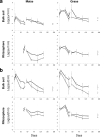Increased abundance and transferability of resistance genes after field application of manure from sulfadiazine-treated pigs
- PMID: 23315733
- PMCID: PMC3591935
- DOI: 10.1128/AEM.03172-12
Increased abundance and transferability of resistance genes after field application of manure from sulfadiazine-treated pigs
Abstract
Spreading manure containing antibiotics in agriculture is assumed to stimulate the dissemination of antibiotic resistance in soil bacterial populations. Plant roots influencing the soil environment and its microflora by exudation of growth substrates might considerably increase this effect. In this study, the effects of manure from pigs treated with sulfadiazine (SDZ), here called SDZ manure, on the abundance and transferability of sulfonamide resistance genes sul1 and sul2 in the rhizosphere of maize and grass were compared to the effects in bulk soil in a field experiment. In plots that repeatedly received SDZ manure, a significantly higher abundance of both sul genes was detected compared to that in plots where manure from untreated pigs was applied. Significantly lower abundances of sul genes relative to bacterial ribosomal genes were encountered in the rhizosphere than in bulk soil. However, in contrast to results for bulk soil, the sul gene abundance in the SDZ manure-treated rhizosphere constantly deviated from control treatments over a period of 6 weeks after manuring, suggesting ongoing antibiotic selection over this period. Transferability of sulfonamide resistance was analyzed by capturing resistance plasmids from soil communities into Escherichia coli. Increased rates of plasmid capture were observed in samples from SDZ manure-treated bulk soil and the rhizosphere of maize and grass. More than 97% of the captured plasmids belonged to the LowGC type (having low G+C content), giving further evidence for their important contribution to the environmental spread of antibiotic resistance. In conclusion, differences between bulk soil and rhizosphere need to be considered when assessing the risks associated with the spreading of antibiotic resistance.
Figures



References
-
- Burkhardt M, Stamm C, Waul C, Singer H, Müller S. 2005. Surface runoff and transport of sulfonamide antibiotics and tracers on manured grassland. J. Environ. Qual. 34:1363–1371 - PubMed
-
- Sarmah AK, Meyer MT, Boxall ABA. 2006. A global perspective on the use, sales, exposure pathways, occurrence, fate and effects of veterinary antibiotics (VAs) in the environment. Chemosphere 65:725–759 - PubMed
-
- Heuer H, Focks A, Lamshöft M, Smalla K, Matthies M, Spiteller M. 2008. Fate of sulfadiazine administered to pigs and its quantitative effect on the dynamics of bacterial resistance genes in manure and manured soil. Soil Biol. Biochem. 40:1892–1900
-
- Lamshöft M, Sukul P, Zühlke S, Spiteller M. 2007. Metabolism of 14C-labelled and non-labelled sulfadiazine after administration to pigs. Anal. Bioanal. Chem. 388:1733–1745 - PubMed
-
- Lamshöft M, Sukul P, Zühlke S, Spiteller M. 2010. Behaviour of 14C-sulfadiazine and 14C-difloxacin during manure storage. Sci. Total Environ. 408:1563–1568 - PubMed
Publication types
MeSH terms
Substances
LinkOut - more resources
Full Text Sources
Other Literature Sources
Medical

